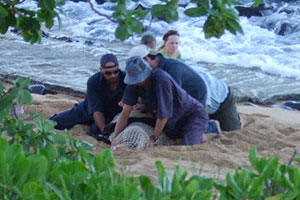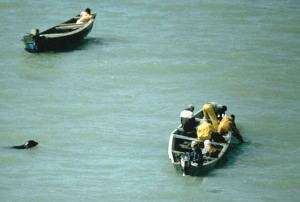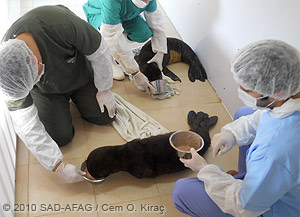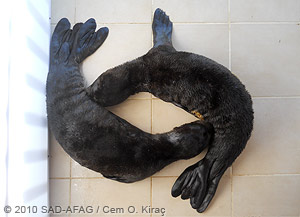Media Watch, Joan Conrow, KauaiEclectic, 26 January 2011
 […] After swimming at the northern end of the beach, I was heading back when I spotted four men and two women mugging an endangered Hawaiian monk seal that I’d previously seen sleeping peacefully among the rocks. The seal’s face was covered with a net, but its eyes met mine and they conveyed terror, which left me with a sickeningly disturbed feeling that still lingers.
[…] After swimming at the northern end of the beach, I was heading back when I spotted four men and two women mugging an endangered Hawaiian monk seal that I’d previously seen sleeping peacefully among the rocks. The seal’s face was covered with a net, but its eyes met mine and they conveyed terror, which left me with a sickeningly disturbed feeling that still lingers.
Although signs erected around a snoozing seal further down the beach warned the public to stay away, this group was allowed to conduct the equivalent of an alien abduction— taking blood and fat samples, swabbing all its orifices and gluing a radio transmitter onto its back — because they are federal scientists striving to protect the seal, or at least help us humans figure out how to do so — provided it doesn’t cause our species too much inconvenience.
While I understand the NOAA and NMFS folks have the very best intentions — which, as well know, also pave the proverbial road to hell — if you check out the Programmatic Environmental Impact Statement for studying the dwindling seal population, you really have to wonder just how much trauma will be inflicted upon these native marine mammals in an effort to “recover” them. […]
Full Story: KauaiEclectic


 Medical waste and other trash continued to soil Leeward Coast beaches yesterday, washing ashore in spots farther down the shore from where the debris was initially found. […]
Medical waste and other trash continued to soil Leeward Coast beaches yesterday, washing ashore in spots farther down the shore from where the debris was initially found. […] Two orphaned Mediterranean monk seal pups are being treated at a rehabilitation facility in Foça, Turkey, according to a press release issued by Turkish NGO
Two orphaned Mediterranean monk seal pups are being treated at a rehabilitation facility in Foça, Turkey, according to a press release issued by Turkish NGO  “Both seals,” says SAD-AFAG’s Cem Orkun Kıraç, “have fully been managing to ‘drink’ the fish porridge from the cups, ingesting the whole food slowly but without any problem since the 26th and 31st December 2010.”
“Both seals,” says SAD-AFAG’s Cem Orkun Kıraç, “have fully been managing to ‘drink’ the fish porridge from the cups, ingesting the whole food slowly but without any problem since the 26th and 31st December 2010.”